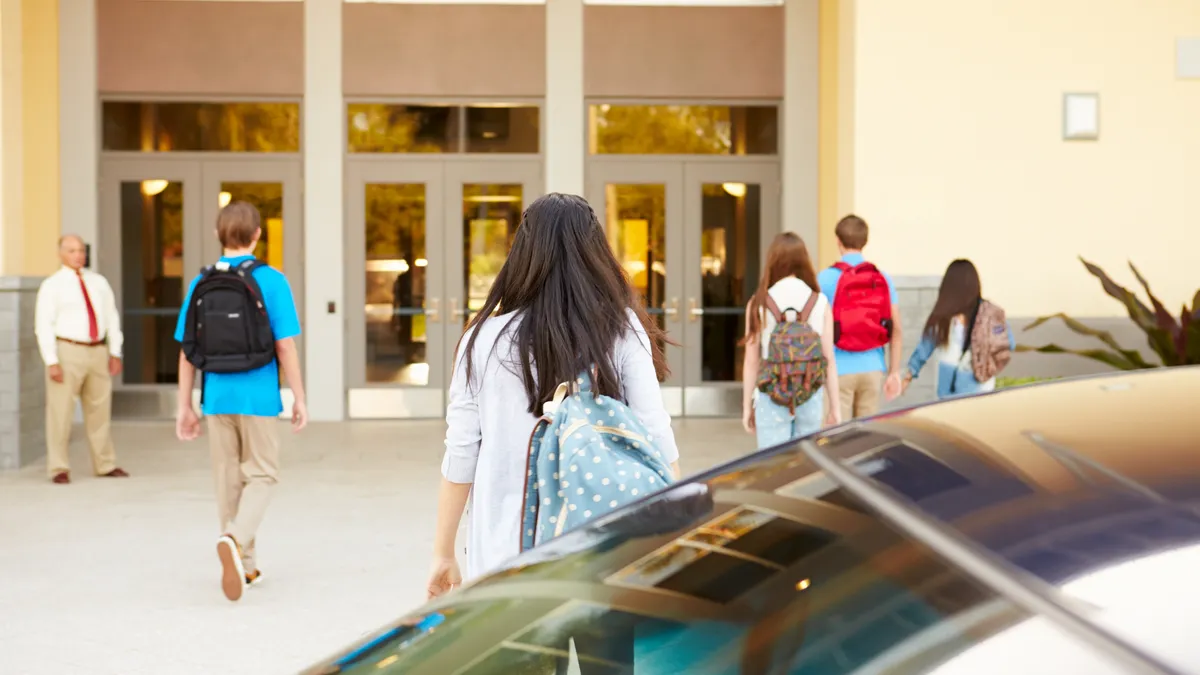Curriculum: Page 54
-
Deep Dive
3 ways educators can dig deeper in lessons on historical conflicts
With milestone anniversaries for D-Day and the Treaty of Versailles this month, history educators can dig deeper to re-engage students rather than rehashing the same primary details.
By Lauren Barack • June 5, 2019 -
 Courtesy of Allison Shelley/The Verbatim Agency for American Education: Images of Teachers and Students in Action.
Courtesy of Allison Shelley/The Verbatim Agency for American Education: Images of Teachers and Students in Action.
Principals, teachers prioritize social-emotional skills for students
The new RAND Corp. survey results come as Congress proposes $260 million in funding for SEL programs and whole-child initiatives.
By Linda Jacobson • May 30, 2019 -
 Explore the Trendline➔
Explore the Trendline➔
 Stock Photo via Getty Images
Stock Photo via Getty Images Trendline
TrendlineTop 5 stories from K-12 Dive
K-12 Dive has gathered some a selection of our best coverage from 2025 so far as a one-stop resource on the trends to watch in the months ahead.
By K-12 Dive staff -
District shifts strategy to provide personalized roadmap
By adapting class schedules and using a new approach to grading, Utah's Juab School District aims to treat students as individuals.
By Lauren Barack • May 29, 2019 -
As McGraw-Hill explores AR tools for chemistry, how can schools test the waters?
There are a number of inexpensive augmented reality apps curriculum directors and teachers can test in the classroom for a taste of what the tech has to offer.
By Lauren Barack • May 29, 2019 -
Student-led curriculum more engaging, but pitfalls remain
Before encouraging teachers to adopt the approach, chief academic officers must consider that not all students could be inspired by a given, popular idea, or that teachers might need additional prep time for lessons.
By Lauren Barack • May 29, 2019 -
Diverse role models shape the futures students envision
Studies show while 70% of 6-year-olds draw a woman when asked to sketch a scientist, just 16% of 16-year-old girls do the same, highlighting the importance of representation in how students perceive future career fields.
By Lauren Barack • May 29, 2019 -
Q&A
Common Cents: George Lucas Foundation details strategy of exploring innovation without being prescriptive
Co-founder Steve Arnold says the foundation's goal is to inspire and inform by sharing what's working, rather than telling educators what to do.
By Roger Riddell • May 23, 2019 -
Reading out loud can benefit students of all ages
Stronger critical thinking and comprehension skills are among the benefits for students when teachers read aloud.
By Lauren Barack • May 22, 2019 -
Wearables may boost physical education — if data is used appropriately
It's important for school leaders to consider how health data on students is used and stored.
By Lauren Barack • May 22, 2019 -
Vetting digital resources on tough topics offers additional media literacy opportunity
Finding reliable resources on topics like climate change can be difficult, but the process also offers opportunities for lessons on critical thinking.
By Lauren Barack • May 22, 2019 -
Deep Dive
Take STEM lessons outside of the box with these 3 approaches
Meeting student demand for "participation in fun, science-related projects and competitions" may not be as difficult as it sounds.
By Lauren Barack • May 22, 2019 -
As K-12 virtual reality use grows, researchers consider impact on children
While the long-term effects on development remain unclear, experts recommend limiting time and ensuring that immersive media experiences are "positive, productive and safe."
By Linda Jacobson • May 22, 2019 -
Computational thinking bridges gaps between subjects
A 5th-grade teacher makes the case that the skill, often associated with STEM, can also help students grasp connections between content areas like writing and the arts.
By Lauren Barack • May 15, 2019 -
Project-based learning engages students while encouraging higher-order thought
Hands-on experiences make it easier for educators to demonstrate how a topic relates to the real world, imparting a deeper understanding of material.
By Lauren Barack • May 15, 2019 -
Incorporating mindfulness reduces anxiety, boosts focus for students and teachers
An instructional coach suggests using reflection as a regular practice allows students to examine their progress and what they can learn from their work.
By Lauren Barack • May 15, 2019 -
Parents' struggles highlight literacy curricula shortcomings for students with dyslexia
Efforts by parents in Arkansas to advocate for change highlight a literacy blindspot that is still a challenge for many schools and districts nationwide.
By Lauren Barack • May 15, 2019 -
Report: Low-income, male students less likely to play instruments at home
The data has implications for student comprehension in math, which becomes easier to understand by studying music theory or playing an instrument.
By Lauren Barack • May 8, 2019 -
Visual, collaborative annotations breathe new life into note-taking
Instead of simply highlighting notable excerpts, a South Carolina English teacher's students draw sketches to illustrate main concepts in a text.
By Lauren Barack • May 8, 2019 -
High-achieving students increasingly turning to CTE courses
Experts say the gaps could be due to gender norms, the cost of musical instruments and private lessons, or unequal access to school music classes.
By Lauren Barack • May 8, 2019 -
Partnerships help schools inject financial literacy into curriculum
Just 17 states mandate a personal finance course for high schoolers. But with organizations underwriting financial literacy programs as part of community partnerships, more schools are getting access to this material.
By Lauren Barack • May 8, 2019 -
Report: Industry credentials earned in high school out of step with employer demand
Research on 24 states' career and technical education programs found 10 of the top 15 credentials earned are oversupplied in the job market.
By Linda Jacobson • May 8, 2019 -
Roundup: Curriculum in state education policy
Sex education and school choice are two of the top subjects up for debate in state legislatures. Education Dive has updates on key proposals.
By Jessica Campisi • May 8, 2019 -
Report: Teach STEM using laughter, creative techniques
Besides interjecting laughter, a study by the Society for Industrial and Applied Mathematics found that teachers should make STEM lessons relatable and use more technology in the classroom.
By Lauren Barack • May 1, 2019 -
Allowing students to retake tests mitigates fear of failure
Educators must be careful, however, to put limits in place so students can't use the opportunity to game the system.
By Lauren Barack • May 1, 2019 -
Universal design for learning spices up lessons with options for all
With more choice in how they tackle an assignment, students may be more involved, excited and motivated — and a broader spectrum of abilities are accounted for.
By Lauren Barack • May 1, 2019

